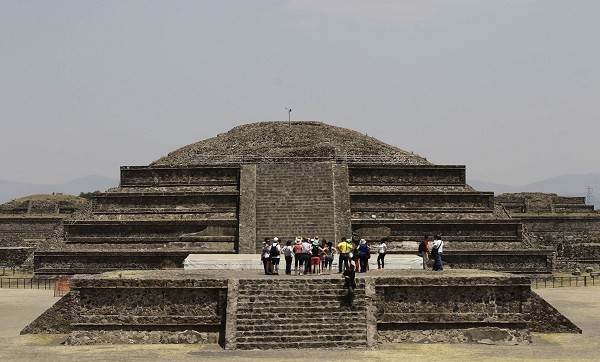
A tiny robot has made a momentous archaeological discovery deep under the famous Temple of Quetzalcoatl, near the Pyramid of the Sun in Mexico, it was announced on Monday.
Experts expected to find just one ancient chamber at the end of a stretch of 2,000-year-old unexplored tunnel at the Teotihuacan site. Instead, the remote-controlled vehicle has beamed back images of three mysterious caverns.
The three-foot-long investigator, named Tlaloc II-TC after the Aztec god of rain, was first lowered into the depths of the pyramid to check it was safe for human entry.
The temple is best known for the towering Pyramids of the Moon and the Sun.
The complex of pyramids, plazas, temples and avenues was once the center of a city of more than 100,000 inhabitants and may have been the largest and most influential city in pre-Hispanic North America at the time.
But nearly 2,500 years after the city was founded – and about 2,100 years after the Teotihuacan culture began to flourish there – very little is known about the identity of its rulers.
No depiction of a ruler, or the tomb of a monarch, has ever been found, setting the metropolis apart from other pre-Hispanic cultures that deified their rulers.
More information, photos and video can be found here.








Ah, exciting news! All I can say is “finally” – because this part of central-american (and world) history went for too long ignored, as these countries having little or no interest in either learning more about or preserving these ruins – they were unfortunately considered a “pagan” or “savage” embarassment to a now predominantly Christian people.
Interest has increased, however, I think with the myths regarding the advent of the end of the Mayan calendar in 2012 – perhaps these countries realized how lucrative a global interest in these places could be
I’m excited to see what we can learn from what’s left – the identity of the “demi-god” Quetzacoatl has long been a mystery, so I’m hoping that “Teotihuacan” (meaning “the place where men became Gods”) can tell us a bit more about him, as well as how the Aztecs and the Mayans were able to accomplish so many similar technological/scientific achievements to European and Asian cultures, without contact with them yet – in fact, years ahead of them,in many ways.
Thanks for this info, Cherie – one thing I missed in the article, though – did Tlaloc II determine whether it was safe for human entrance yet?:)
(P.S. “Tlaloc” – you need someone from Mayan or Aztec descent can pronounce this god’s name the correct way because we never will
I am glad you found it interesting and thanks for your additional information. I am fascinated by anything like this
I certainly wouldn’t try and pronounce the name, I just look at the name as pattern.
Well that’s really cool! And I was right there in January of 2012. So many amazing archaeological sites in Mexico.
Oh! I bet that was a wonderful experience, I would love to visit some of these ancient sights around the world.
aaah … brings back memories …. was a little afraid wandering around a similar temple
Which one did you have the privilege to visit?
Did you have a great time in Mexico?
I am sure I would have if I had been there
Ah, Quetzalcoatl. What a mythology. I had the pleasure to live near a museum that had magnificent exhibitions of the Aztecs and the Mayas … in the past millennium.
And I met a descendant of Quetzalcoatl. : )
In my next life I’d like to visit Mexico … when the druglords have turned to ash.
The museum sounds fascinating
And I met a descendant of Quetzalcoatl.
I am curious to hear more about that